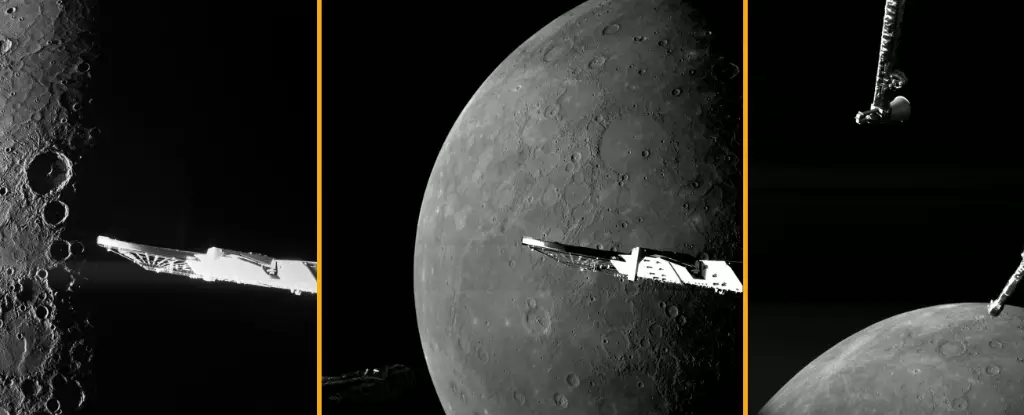On its remarkable voyage, the European Space Agency’s (ESA) BepiColombo probe has brought humanity closer to understanding one of our solar system’s most enigmatic planets—Mercury. Positioned a mere 295 kilometers above Mercury’s surface during its final flyby, the spacecraft has captured mesmerizing images that reflect a planet caught in a dance of extreme weather. With these precious snapshots, scientists are on the brink of gleaning insights into Mercury’s history and its implications for planetary evolution.
The imagery portrays a harsh, sun-scorched world characterized by eternal daylight and pockets of permanent darkness. One particularly intriguing aspect of these images is the discovery of shadowed crater rims that may harbor ice. This frozen water could potentially unlock secrets about Mercury’s past climatic conditions and its capacity for preserving ancient material. According to Geraint Jones, the ESA Project Scientist, the upcoming weeks will witness intensive analysis by the BepiColombo team as they endeavor to decipher the multitude of mysteries presented by these images.
Mercury, often referred to as the closest planet to the Sun, is akin to a cosmic orphan. Its small size—only slightly larger than the Moon—belies its significance. With an average distance of about 58 million kilometers (36 million miles) from our star, it experiences extreme temperatures that oscillate drastically. At midday, temperatures soar to a searing 430 degrees Celsius (over 800 degrees Fahrenheit), while the shadows can plunge to a frigid minus 180 degrees Celsius. Such extreme conditions create an environment that challenges our traditional understanding of planetary atmospheres and geophysical processes.
One of the most puzzling aspects of Mercury is its enigmatic magnetic field. Designed specifically to investigate this phenomenon, BepiColombo aims to shed light on the mechanisms that generate this magnetic field and explore the potential for other hidden treasures beneath the surface. Recent theories suggest that a significant reservoir of carbon may exist, possibly taking the form of diamond. Additionally, observations indicate that Mercury may be contracting over geological timescales, hinting at dynamic processes occurring beneath its crust.
Launched in October 2018, BepiColombo is not just a mission of discovery; it is a sophisticated scientific operation that promises to enhance our understanding of Mercury’s characteristics. The spacecraft is expected to provide extensive data regarding the planet’s magnetism, gaseous exosphere, and surface features—insights critical for piecing together the planetary puzzle.
Among the stunning images captured, features like the Nathair Facula stand out, showcasing signs of Mercury’s largest known volcanic eruption, marked by a prominent vent that measures approximately 40 kilometers across. This geological signature offers a glimpse into the planet’s tumultuous volcanic history, punctuated by major impacts and the rejuvenating forces of extraordinary eruptions. Nearby, the relatively youthful Fonteyn crater, formed just 300 million years ago, contrasts starkly against the backdrop of an otherwise ancient landscape.
Mercury’s surface tells a story of resilience, transformation, and gradual decay, arising from both external impacts and internal processes. Each crater and geological formation serves as a chapter in the planet’s narrative—one of rebirth amid the relentless passage of time.
As BepiColombo continues its mission, the anticipation grows for what lies ahead. In 2026, the spacecraft’s Mercury Transfer Module will return to the planet, releasing two orbiters that will extensively study Mercury from their respective altitudes. While neither orbiter is projected to descend within 480 kilometers of the surface, the ongoing data collection will significantly enhance our overall understanding of this intriguing celestial body.
The exploration of Mercury through the eyes of BepiColombo is set to transform our scientific perspective. As we await the fruits of these efforts, the harrowing beauty of this primal world—both its striking landscapes and its hidden enigmas—remains an exhilarating reminder of the unknowns still obscured in our own cosmic backyard. The expedition to Mercury encapsulates the spirit of discovery, a beacon of curiosity guiding us toward new frontiers in planetary science.

Leave a Reply